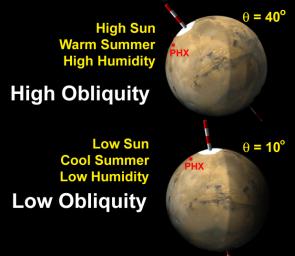
|
Mars Obliquity Cycle Illustration
- Click the image above for a larger view
- Full-Res JPEG (3456 x 3000) (451.3 kB)
- Full-Res TIFF (3456 x 3000) (31.1 MB)
Caption:
The tilt of Mars' spin axis (obliquity) varies cyclically over hundreds of thousands of years, and affects the sunlight falling on the poles. Because the landing site of NASA's Phoenix Mars Lander is so near the north pole, higher sun and warmer temperatures during high obliquity lead to warmer, more humid surface environments, and perhaps thicker, more liquid-like films of water in soil.
Background Info:
The Phoenix Mission is led by the University of Arizona, Tucson, on behalf of NASA. Project management of the mission is by NASA's Jet Propulsion Laboratory, Pasadena, Calif. Spacecraft development is by Lockheed Martin Space Systems, Denver.
Photojournal Note: As planned, the Phoenix lander, which landed May 25, 2008 23:53 UTC, ended communications in November 2008, about six months after landing, when its solar panels ceased operating in the dark Martian winter.
Cataloging Keywords:
| Name | Value | Additional Values |
|---|---|---|
| Target | Mars | |
| System | ||
| Target Type | Planet | |
| Mission | Phoenix | |
| Instrument Host | Phoenix Lander | |
| Host Type | Lander | |
| Instrument | ||
| Detector | ||
| Extra Keywords | Color, Rotation, Water | |
| Acquisition Date | ||
| Release Date | 2008-12-15 | |
| Date in Caption | ||
| Image Credit | NASA/JPL/University of Arizona | |
| Source | photojournal.jpl.nasa.gov/catalog/PIA11714 | |
| Identifier | PIA11714 | |
